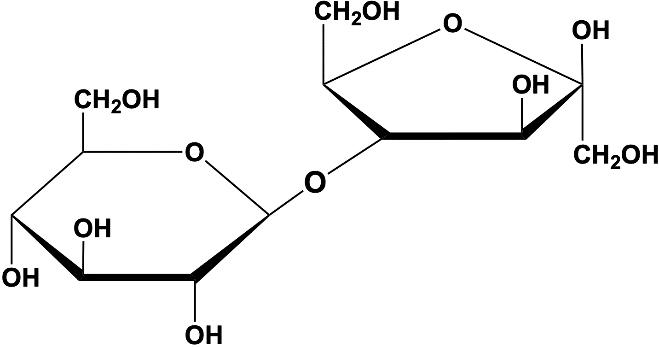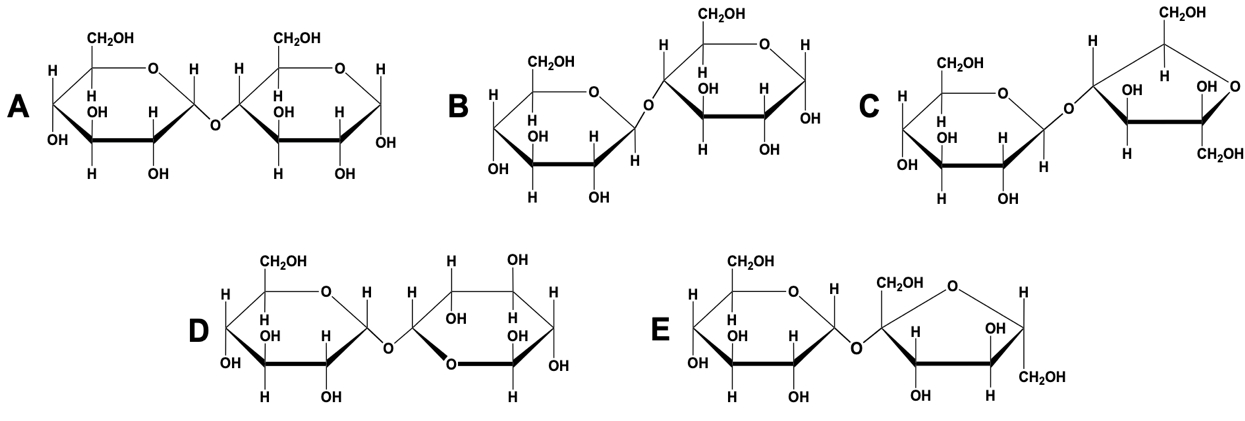And so if we take a look down below at our image, notice that we have these 3 different disaccharides in each of these 3 different boxes. And so the goal is to name the following glycosidic bonds in each of these disaccharides. So we can start with this one over here on the far left and notice that we have 2 sugar units. We've got this sugar unit right here and then we've got this other sugar unit over here. And of course, if we want to name the glycosidic bonds, then we're going to need to consider the configuration of the anomeric carbon or carbons involved in the glycosidic linkage. And so we need to find the anomeric carbon of this sugar over here on the left-hand side. And recall that the anomeric carbon is the only carbon atom bonded to 2 oxygen atoms. So that would be this carbon atom right here which is assigned the lowest possible number, carbon 1. And notice that it's bonded to this ring oxygen and this other oxygen over here. And notice that the glycosidic linkage that we see here is an O-glycosidic linkage since the anomeric carbon is bonded to an oxygen atom. And so what we need to realize here is that this glycosidic linkage is actually pointing in a downwards direction. In the opposite direction of the highest-numbered carbon, which is pointing upwards. And so it seems as if this glyco bond is reaching down to the ants and so that is going to be an alpha configuration. And so, this is, indeed, going to be alpha. And, what we'll notice is that the anomeric carbon of the sugar over here on the right-hand side is actually way over here on the right. So it's actually not participating in this glycosidic linkage over here. And so, what that means is we're not going to consider the configuration of this anomeric carbon in the naming of this glycosidic bond. So now with that, we're done with this first step here. We can move on to the second step which is again, going to be the numbering of the carbon atoms involved in the glycosidic linkage. And so notice that we have, the anomeric carbon of the sugar on the left as C1. And notice that the carbon atom over here of this sugar on the right-hand side is actually C4 since, again, its anomeric carbon is over here as one. And then when we number these, this carbon ends up being C4. And so what that means is that, we have an alpha one four glycosidic linkage. And so really this is the name of this linkage that we see here. It's an alpha one four glycosidic linkage. Now notice that we only have a single-headed arrow right here because we only have 1 anomeric carbon involved in the bond. However, an alternative way to write this name of the glycosidic bond is to replace this arrow with a comma. And so an alternative way to write this would be an alpha one comma and alpha 1 comma 4 glycosidic bond. And again, that, is perfectly acceptable.
So now moving on to this second dissect right here in the middle. Again, notice we have 2 sugar units, 1 up here on the top and then one down here on the bottom. And so what you'll notice here is that for the top sugar, the anomeric carbon is again this lowest-numbered carbon right here. And what you'll notice is that the linkage that's forming here is an O-glycosidic linkage since the anomeric carbon is bonded to an oxygen atom. And the O-glycosidic linkage seems to be going again in a downwards direction here, away in the opposite direction of the highest-numbered carbon, which is going up. And so, what this means is that, we're definitely going to have an alpha configuration again. And so we can put alpha down here. And then notice for this sugar way down here, its anomeric carbon is actually way over here. And so it's not involved in this glycosidic linkage here. And so for that reason, we're not going to include the configuration of this animere carbon in the naming of this glycosidic linkage. So now that we're done with the configuration, we can move on to the numbering of the carbon atoms. And so again, we can see that carbon number 1 of the top sugar is involved in the glycosidic linkage, so alpha 1. And then notice that it's actually carbon number 6 of the bottom sugar that's involved in the glycosidic linkage. So this is an alpha one 6 glycosidic linkage right here. And so again, notice that we have a single-headed arrow here because there's only 1 anomeric carbon involved in the glycosidic linkage. But an alternative way to write this would be to replace the arrow again with a comma. And so, we could rewrite this as just an alpha one comma 6 glycosidic linkage, and that is again perfectly acceptable.
So now moving on to our final disaccharide over here on the right-hand side. Again, notice that we have 2 sugars units, involved in this disaccharide, highlighted as shown. And so we want to look for the anomeric carbon. And so, of this sugar over here, notice the anomeric carbon is right here. And, notice that it's forming an O-glycosidic linkage since the anomeric carbon is bonded to this oxygen atom right over here. And so notice that this glycosidic linkage seems to be going in an upwards direction here. It goes upwards and then it curls, it's curling back downwards. But initially, it's going upwards in the same direction as the highest-numbered carbon. And so, of course, this is going to be a beta configuration since the bumps of the beta go on the same side. These two arrows are going in the same side. So this is a beta configuration. So we can put beta here. And then when we take a look at this sugar over here, notice that its anomeric carbon is not over here this time. Instead, its anomeric carbon is right over here. Since this is the carbon atom that's bonded to 2 oxygen atoms. The ring oxygen and this oxygen over here. And so notice that with this anomeric carbon, it's also forming an O-glycosidic linkage since it's bonded to this oxygen. But with this anomeric carbon, notice that the bond is actually going in a downwards direction initially here. And so, it's going in the opposite direction as the highest-numbered carbon which is going up. And so what that means is that for this sugar over here on the right, we need to consider the configuration since it's involved in the glycosidic linkage. And so, what you'll note is that it's going to have an alpha glycosidic linkage, and we can put that over here. And notice that because 2 anomeric carbons are involved in this glycosidic linkage, that we have a double-headed arrow right here. So now that we've considered the configuration of both anomeric carbons, we can move on to the numbering of the carbon atoms involved in the glycosidic linkage. And of course because we have 2 anomeric carbons involved, they're both going to be assigned the lowest possible number here. And so, they're both going to be assigned to number 1. So we have a beta one right here, and then an alpha one, right here. And so this entire glycosidic linkage right here is going to be called a beta one alpha one glycosidic linkage. And again, the double-headed arrow can be replaced by a comma. So it could also be written as beta 1 comma alpha one glycosidic linkage. So this is another acceptable way to write this glycosidic linkage. And so the best way to understand the naming of glycosidic bonds is to get practice applying these concepts. So as we move forward in our course, we'll be able to get some more practice doing that. And so I'll see you guys in our next video.





